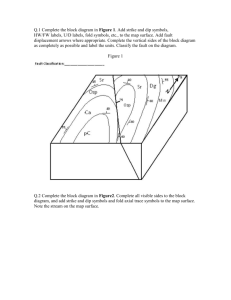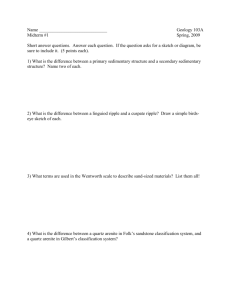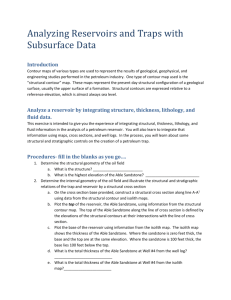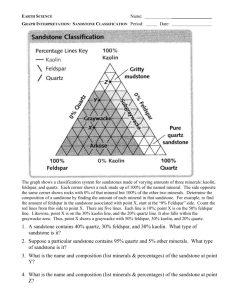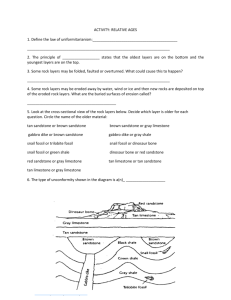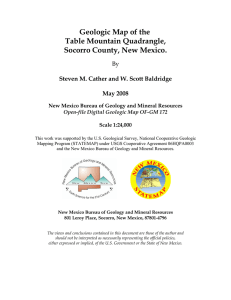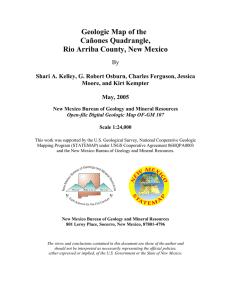Writing Tips for Scientific Papers
advertisement
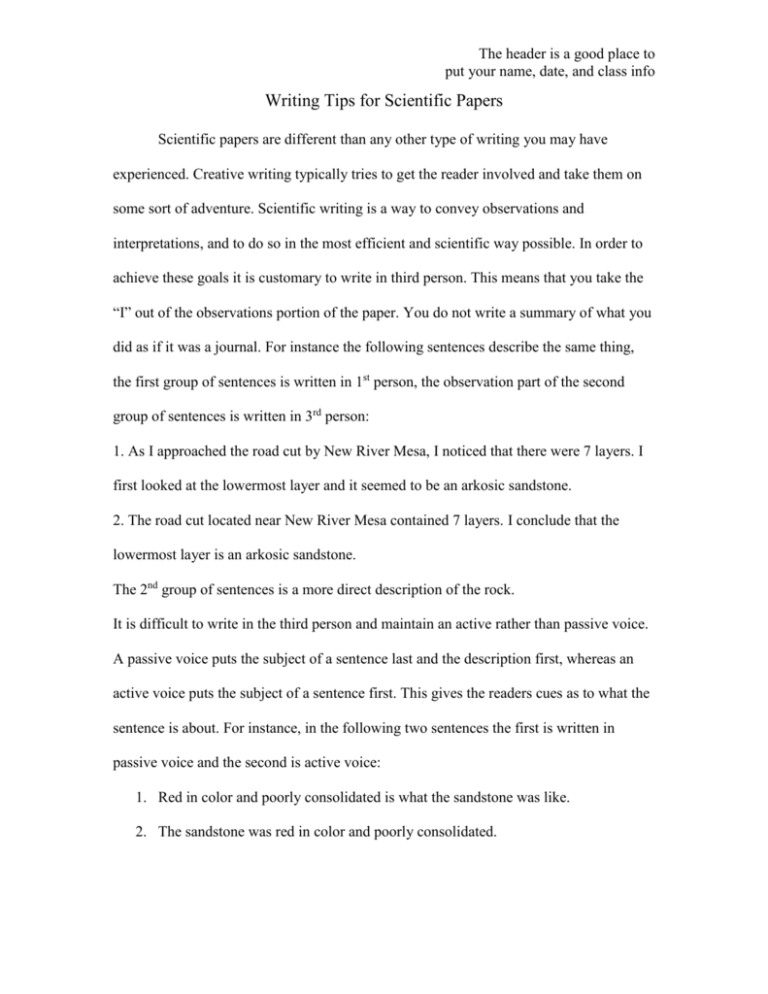
The header is a good place to put your name, date, and class info Writing Tips for Scientific Papers Scientific papers are different than any other type of writing you may have experienced. Creative writing typically tries to get the reader involved and take them on some sort of adventure. Scientific writing is a way to convey observations and interpretations, and to do so in the most efficient and scientific way possible. In order to achieve these goals it is customary to write in third person. This means that you take the “I” out of the observations portion of the paper. You do not write a summary of what you did as if it was a journal. For instance the following sentences describe the same thing, the first group of sentences is written in 1st person, the observation part of the second group of sentences is written in 3rd person: 1. As I approached the road cut by New River Mesa, I noticed that there were 7 layers. I first looked at the lowermost layer and it seemed to be an arkosic sandstone. 2. The road cut located near New River Mesa contained 7 layers. I conclude that the lowermost layer is an arkosic sandstone. The 2nd group of sentences is a more direct description of the rock. It is difficult to write in the third person and maintain an active rather than passive voice. A passive voice puts the subject of a sentence last and the description first, whereas an active voice puts the subject of a sentence first. This gives the readers cues as to what the sentence is about. For instance, in the following two sentences the first is written in passive voice and the second is active voice: 1. Red in color and poorly consolidated is what the sandstone was like. 2. The sandstone was red in color and poorly consolidated. The header is a good place to put your name, date, and class info The second sentence gives the reader an idea of what the sentence is about very quickly: the sandstone. In addition, the first sentence in a paragraph should state what the paragraph is about. So a formula for an active third person voice is: 1. Topic sentence of a paragraph gives the reader information about what to expect from the paragraph, 2. The first half of the sentence should include the subject, 3. Keep the “I” out of the observations portion of the paper. Scientific papers are not a list or summary of your notes. Although the data in your paper come from your notes, they need to be refined. In the field, it saves time to list your observations tersely. In your paper, you need to smooth and indicate interrelations among the listed descriptions by using bridging words such as: such as, similarly, in addition to, moreover, besides, further more, thus, conversely. In addition, it is important to differentiate observations and interpretations both in your notes and in your paper. Separating observations from interpretations is very important in scientific papers. The observations you make are fact-based. The observations section is what is seen and present in the study area. This section of your paper should not include “I”, this is not a journal. The interpretations you make come from the observations. In this section it is good to take ownership of your work. For instance: The rock contains well-sorted, very rounded clasts of silica. I interpret this rock to be a sandstone. In this case, the observations are separate from the interpretations, there is no “I” in the observations and finally the author takes responsibility for his or her work in the interpretations section. Commonly the paper can be separated into an observations section and an interpretations section. The header is a good place to put your name, date, and class info A scientific abstract also does not need to discuss the theory behind your convictions. The abstract is a summary. Often someone will just read your abstract to decide if they want to read your paper. It should stand alone as a representation of your work. So the abstract should include why the study was conducted, where the study was conducted, what the study encompassed, observations that lead to a particular, important interpretation, and finally any other pertinent data. Some things that can be done to increase the presentation of your paper are double space, put your name as a header, and have just a short title. Double spacing is really nice in your papers. Although professional scientific journals present the text single spaced, it is difficult to edit with no room to write comments. Because double spacing takes up page space it is efficient to put your name and information in a header so that it does not take up as much room. Finally, for this exercise, a short title is appropriate. The title should convey the paper’s topic efficiently. For instance the two titles below, the 1st one is the most efficient: 1. New River Mesa, Road Cut Geology 2. The Geology of a Road Cut in Central Arizona, Near New River Mesa If the reader wants further information about the paper they can then read the abstract. Editing papers is a big responsibility. When editing a paper it is beneficial to have a dictionary of geologic terms beside you so that you can check the spelling of words that the word processor does not recognize. It is also highly recommended to print your paper and read it out loud. You will be astounded the number of mistakes you find when reading a paper out loud. Anytime you stumble or are forced to hesitate when The header is a good place to put your name, date, and class info reading your paper, there is typically a correction necessary. Do not edit your papers solely on the computer. Common mistakes include number agreement, capitalization, and the tense of descriptions. Here is an example of number agreement. The first sentence is incorrect and the second sentence is correct: 1. The three cats was walking down the street. 2. The three cats were walking down the street. It is also customary to capitalize proper names of rocks like: Dox Sandstone and Troy Quartzite. Do not capitalize the rock type if it is not a proper name: sandstone and quartzite. Similarly do not capitalize east, west, north, south, northeastern, northwestern, etc. Finally it is a good idea, but not required, to describe rocks as if they are still where they were when observed and have the same properties: “The sandstone is composed of subrounded, 1mm sized clasts” Vs. “The sandstone was composed of 1mm sized subrounded clasts.”

